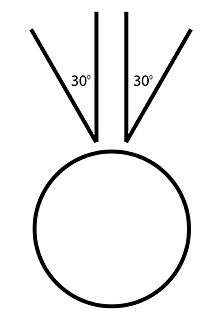30-degree rule

The 30-degree rule is a basic film editing guideline that states the camera should move at least 30 degrees between shots of the same subject occurring in succession. If this rule is not followed, a jump cut occurs and there is a risk that the audience starts focusing on the filming technique instead of the story that is being narrated.[1]
The 30 degree change of perspective makes the shots different enough to avoid a jump cut. Too much movement around the subject may violate the 180-degree rule. Following this rule may soften the effect of changing shot distance, such as changing from a medium shot to a close-up or extreme close-up.
The 30 degree rule has its origin from the beginning of the 20th century. The legendary French filmmaker George Méliès, producer of silent black-and-white film, inspired succeeding filmmakers to heed this rule of angle when cutting between similar or nearly identical clips. When Mèliés himself made his famous A Trip to the Moon in 1902 he tried to edit together film clips of the same framing and with the same angle, after changing the scene between the shots, to make it look like there was no cut at all. It was the world's first attempt to make special effects.[1]
As Timothy Corrigan and Patricia White suggest in The Film Experience, "The rule aims to emphasize the motivation for the cut by giving a substantially different view of the action. The transition between two shots less than 30 degrees apart might be perceived as unnecessary or discontinuous--in short, visible."[2]
The rule is a special case of a more general dictum that states that the cut will be jarring if the two shots being cut are so similar that there appears to be a lack of motivation for the cut. In his book In The Blink of an Eye, editor Walter Murch states:
[We] have difficulty accepting the kind of displacements that are neither subtle nor total: Cutting from a full-figure master shot, for instance, to a slightly tighter shot that frames the actors from the ankles up. The new shot in this case is different enough to signal that something has changed, but not different enough to make us re-evaluate its context.[3]
The axial cut is a striking violation of this rule to obtain a certain effect.
References
- 1 2 http://www.hollywoodlexicon.com/thirtydegree.html
- ↑ 2004, 130
- ↑ 2006, 6
External links
- "The 30-degree rule", an article explaining the 30-degree rule in depth (showcasing examples and counterexamples from various films).